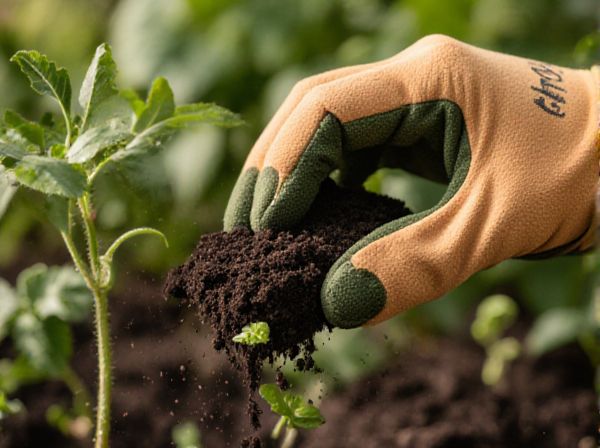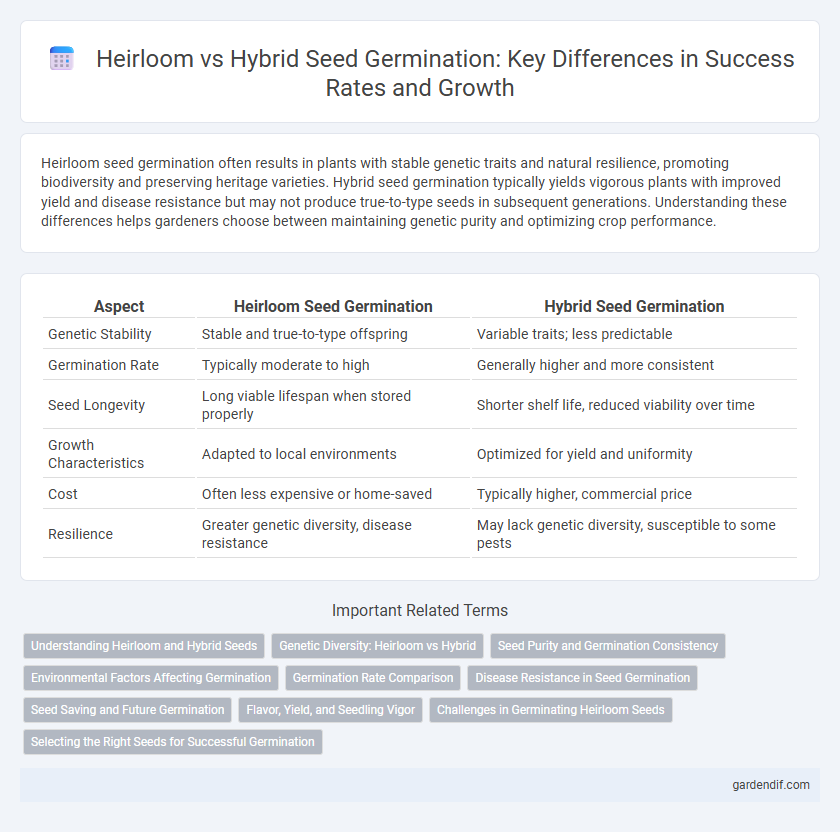
Heirloom Seed Germination vs Hybrid Seed Germination Illustration
Heirloom seed germination often results in plants with stable genetic traits and natural resilience, promoting biodiversity and preserving heritage varieties. Hybrid seed germination typically yields vigorous plants with improved yield and disease resistance but may not produce true-to-type seeds in subsequent generations. Understanding these differences helps gardeners choose between maintaining genetic purity and optimizing crop performance.
Table of Comparison
| Aspect | Heirloom Seed Germination | Hybrid Seed Germination |
|---|---|---|
| Genetic Stability | Stable and true-to-type offspring | Variable traits; less predictable |
| Germination Rate | Typically moderate to high | Generally higher and more consistent |
| Seed Longevity | Long viable lifespan when stored properly | Shorter shelf life, reduced viability over time |
| Growth Characteristics | Adapted to local environments | Optimized for yield and uniformity |
| Cost | Often less expensive or home-saved | Typically higher, commercial price |
| Resilience | Greater genetic diversity, disease resistance | May lack genetic diversity, susceptible to some pests |
Understanding Heirloom and Hybrid Seeds
Heirloom seeds are open-pollinated varieties preserved over generations, offering genetic diversity and true-to-type plants with consistent traits, making them ideal for gardeners valuing heritage and seed saving. Hybrid seeds result from crossbreeding two distinct parent plants to produce offspring with improved vigor, yield, or disease resistance but often do not breed true in subsequent generations, requiring purchase of new seeds each season. Understanding these differences helps gardeners decide between preserving biodiversity with heirlooms or maximizing performance with hybrids during germination planning.
Genetic Diversity: Heirloom vs Hybrid
Heirloom seed germination preserves greater genetic diversity, offering plants with varied traits and adaptability to local environments. Hybrid seed germination typically results in uniform offspring with specific desired characteristics but reduced genetic variation. This limited genetic diversity in hybrids can make crops more vulnerable to diseases and environmental changes compared to heirlooms.
Seed Purity and Germination Consistency
Heirloom seed germination maintains high seed purity due to open-pollination, preserving genetic traits over generations and ensuring consistent plant characteristics. Hybrid seed germination often exhibits greater initial vigor but can result in variability and reduced seed purity in subsequent generations due to cross-pollination and genetic segregation. Understanding these differences is crucial for gardeners prioritizing genetic stability and predictable germination outcomes.
Environmental Factors Affecting Germination
Heirloom seed germination often benefits from stable environmental conditions such as consistent temperature and moisture, as these seeds are adapted to natural cycles with fewer genetic modifications. In contrast, hybrid seeds may require more precise environmental control, including optimal light exposure and soil pH, to maximize germination rates due to their engineered traits. Soil texture, humidity levels, and exposure to pathogens also play significant roles in determining the success of germination for both heirloom and hybrid varieties.
Germination Rate Comparison
Heirloom seeds typically exhibit a lower germination rate compared to hybrid seeds due to their open-pollinated nature and genetic diversity, which offers resilience but less uniformity. Hybrid seeds, bred for specific traits, often have higher and more consistent germination rates, making them preferred for commercial agriculture. Germination rate for heirloom seeds averages around 60-80%, while hybrid seeds usually germinate at rates exceeding 85-95%, reflecting controlled breeding and seed treatment processes.
Disease Resistance in Seed Germination
Heirloom seed germination often results in plants with variable disease resistance due to genetic diversity inherited from open-pollinated seeds, which can enhance resilience in specific environments. Hybrid seed germination typically produces uniform seedlings with targeted disease resistance traits bred for improved protection against common pathogens. Understanding the differences in disease resistance between heirloom and hybrid seed germination can guide growers in selecting seeds best suited for sustainable cultivation and crop health management.
Seed Saving and Future Germination
Heirloom seed germination promotes genetic diversity and allows gardeners to save seeds from each harvest for future planting, ensuring consistent traits and adaptability over generations. Hybrid seed germination often results in decreased viability and unpredictable offspring traits, making seed saving less reliable for maintaining plant characteristics. Choosing heirloom seeds supports sustainable gardening practices through effective seed saving and promotes stable future germination performance.
Flavor, Yield, and Seedling Vigor
Heirloom seed germination often produces plants with superior flavor and richer aroma, preserving unique, traditional tastes lost in many hybrids. Hybrid seed germination tends to result in higher yield and enhanced seedling vigor, offering stronger resistance to diseases and environmental stress. Choosing between heirloom and hybrid seeds depends on prioritizing flavor complexity versus maximizing consistent production and early growth strength.
Challenges in Germinating Heirloom Seeds
Heirloom seed germination presents unique challenges due to their genetic diversity and open-pollinated nature, often resulting in lower and less uniform germination rates compared to hybrid seeds. These seeds may require specific pre-treatment techniques such as stratification or scarification to break dormancy, which are less commonly needed for hybrids. Environmental sensitivity and susceptibility to diseases during germination further complicate the successful sprouting of heirloom varieties.
Selecting the Right Seeds for Successful Germination
Heirloom seed germination often requires more patience and specific conditions due to their open-pollinated nature and genetic diversity, which fosters resilience but may yield variable germination rates. Hybrid seeds, being the result of controlled cross-pollination, typically exhibit higher germination rates and uniform growth, making them ideal for consistent crop production. Selecting the right seed type depends on gardening goals: choose heirlooms for genetic diversity and flavor heritage, and hybrids for reliability and vigor in germination.
Heirloom Seed Germination vs Hybrid Seed Germination Infographic

 gardendif.com
gardendif.com